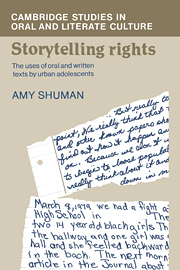Book contents
- Frontmatter
- Contents
- Acknowledgments
- Introduction
- 1 Fight stories: what counts is the recounting
- 2 Storyability and tellability
- 3 Collaborative uses of literacy in the adolescent community
- 4 Retellings
- 5 Varieties of contextuality
- 6 Familiarity and distance: toward a theory of oral and written personal narration
- Notes
- Bibliography
- Index
3 - Collaborative uses of literacy in the adolescent community
Published online by Cambridge University Press: 05 November 2011
- Frontmatter
- Contents
- Acknowledgments
- Introduction
- 1 Fight stories: what counts is the recounting
- 2 Storyability and tellability
- 3 Collaborative uses of literacy in the adolescent community
- 4 Retellings
- 5 Varieties of contextuality
- 6 Familiarity and distance: toward a theory of oral and written personal narration
- Notes
- Bibliography
- Index
Summary
Text and context
Literacy research concerns at least three levels of context. In the most general sense, context is considered as equivalent to culture, or the general social structure of a community and its bearing on the uses of and attitudes toward literacy. The term “cultural context” will be used to refer to this level. On a more particular level, context has been used to refer to the relationship between participants engaged in communication in a situation involving oral or written communication. The terms “situational context” or “context” indicate this level. A third level concerns whether or not speaking and writing constitute different relationships between text and context. (Here the term “context” refers to either or both of these levels, and the term “text” has various definitions.) I use the term “text” both for oral communication transcribed into writing and for written communication, and the terms “strategies,” “conventions,” and “devices” to describe text–context relationships.
The first level, writing in the context of social structure and culture, concerns the consequences and implications of literacy for technological change, worldview, education, communication, and most generally, culture. The increasing amount of scholarly material in this area provides strong backing for a theoretical model of multiple literacies, a variety of ways in which oral and written communication can be categorized.
- Type
- Chapter
- Information
- Storytelling RightsThe Uses of Oral and Written Texts by Urban Adolescents, pp. 77 - 121Publisher: Cambridge University PressPrint publication year: 1986



